ASA/PIX 7.2: Block Certain Websites (URLs) Using Regular Expressions with MPF Configuration Examples
Available Languages
Contents
Introduction
This document describes how to configure the Cisco Security Appliances ASA/PIX 7.2 with Regular Expressions with Modular Policy Framework (MPF) in order to block certain websites (URLs).
Note: This configuration does not block all application downloads. For reliable file blocks, a dedicated appliance, such as Websense, etc., or module, such as the CSC module for the ASA, must be used.
HTTPS filtering is not supported on ASA. ASA cannot do deep packet inspection or inspection based on regular expression for HTTPS traffic because, in HTTPS, the content of packet is encrypted (ssl).
Prerequisites
Requirements
This document assumes that Cisco Security Appliance is configured and works properly.
Components Used
-
Cisco 5500 Series Adaptive Security Appliance (ASA) that runs Software Version 7.2(2)
-
Cisco Adaptive Security Device Manager (ASDM) Version 5.2(2) for ASA 7.2(2)
The information in this document was created from the devices in a specific lab environment. All of the devices used in this document started with a cleared (default) configuration. If your network is live, make sure that you understand the potential impact of any command.
Related Products
This configuration can also be used with the Cisco 500 Series PIX that runs Software Version 7.2(2).
Conventions
Refer to the Cisco Technical Tips Conventions for more information on document conventions.
Background Information
Modular Policy Framework Overview
MPF provides a consistent and flexible way to configure security appliance features. For example, you can use MPF to create a timeout configuration that is specific to a particular TCP application, as opposed to one that applies to all TCP applications.
MPF supports these features:
-
TCP normalization, TCP and UDP connection limits and timeouts, and TCP sequence number randomization
-
CSC
-
Application inspection
-
IPS
-
QoS input policing
-
QoS output policing
-
QoS priority queue
The configuration of the MPF consists of four tasks:
-
Identify the Layer 3 and 4 traffic to which you want to apply actions. Refer to Identifying Traffic Using a Layer 3/4 Class Map for more information.
-
(Application inspection only) Define special actions for application inspection traffic. Refer to Configuring Special Actions for Application Inspections for more information.
-
Apply actions to the Layer 3 and 4 traffic. Refer to Defining Actions Using a Layer 3/4 Policy Map for more information.
-
Activate the actions on an interface. Refer to Applying a Layer 3/4 Policy to an Interface Using a Service Policy for more information.
Regular Expression
A regular expression matches text strings either literally as an exact string, or with metacharacters, so you can match multiple variants of a text string. You can use a regular expression to match the content of certain application traffic; for example, you can match a URL string inside an HTTP packet.
Note: Use Ctrl+V to escape all the special characters in the CLI, such as a question mark (?) or tab. For example, type d[Ctrl+V]g to enter d?g in the configuration.
In order to create a regular expression, use the regex command, which can be used for various features that require text matching. For example, you can configure special actions for application inspection with Modular Policy Framework with an inspection policy map (see the policy map type inspect command). In the inspection policy map, you can identify the traffic you want to act upon if you create an inspection class map that contains one or more match commands, or you can use match commands directly in the inspection policy map. Some match commands let you identify text in a packet with a regular expression; for example, you can match URL strings inside HTTP packets. You can group regular expressions in a regular expression class map (see the class-map type regex command).
Table 1 lists the metacharacters that have special meanings.
| Character | Description | Notes |
|---|---|---|
| . | Dot | Matches any single character. For example, d.g matches dog, dag, dtg, and any word that contains those characters, such as doggonnit. |
| (exp) | Subexpression | A subexpression segregates characters from surrounding characters, so that you can use other metacharacters on the subexpression. For example, d(o|a)g matches dog and dag, but do|ag matches do and ag. A subexpression can also be used with repeat quantifiers to differentiate the characters meant for repetition. For example, ab(xy){3}z matches abxyxyxyz. |
| | | Alternation | Matches either expression it separates. For example, dog|cat matches dog or cat. |
| ? | Question mark | A quantifier that indicates that there are 0 or 1 of the previous expression. For example, lo?se matches lse or lose. Note: You must enter Ctrl+V and then the question mark or else the help function is invoked. |
| * | Asterisk | A quantifier that indicates that there are 0, 1 or any number of the previous expression. For example, lo*se matches lse, lose, loose, and so on. |
| {x} | Repeat quantifier | Repeat exactly x times. For example, ab(xy){3}z matches abxyxyxyz. |
| {x,} | Minimum repeat quantifier | Repeat at least x times. For example, ab(xy){2,}z matches abxyxyz, abxyxyxyz, and so on. |
| [abc] | Character class | Matches any character in the brackets. For example, [abc] matches a, b, or c. |
| [^abc] | Negated character class | Matches a single character that is not contained within the brackets. For example, [^abc] matches any character other than a, b, or c. [^A-Z] matches any single character that is not an uppercase letter. |
| [a-c] | Character range class | Matches any character in the range. [a-z] matches any lowercase letter. You can mix characters and ranges: [abcq-z] matches a, b, c, q, r, s, t, u, v, w, x, y, z, and so does [a-cq-z]. The dash (-) character is literal only if it is the last or first character within the brackets: [abc-] or [-abc]. |
| "" | Quotation marks | Preserves trailing or leading spaces in the string. For example, " test" preserves the leading space when it looks for a match. |
| ^ | Caret | Specifies the beginning of a line. |
| \ | Escape character | When used with a metacharacter, matches a literal character. For example, \[ matches the left square bracket. |
| char | Character | When a character is not a metacharacter, matches the literal character. |
| \r | Carriage return | Matches a carriage return 0x0d. |
| \n | Newline | Matches a new line 0x0a. |
| \t | Tab | Matches a tab 0x09. |
| \f | Formfeed | Matches a form feed 0x0c. |
| \xNN | Escaped hexadecimal number | Matches an ASCII character with hexadecimal (exactly two digits). |
| \NNN | Escaped octal number | Matches an ASCII character as octal (exactly three digits). For example, the character 040 represents a space. |
Configure
In this section, you are presented with the information to configure the features described in this document.
Note: Use the Command Lookup Tool (registered customers only) to obtain more information on the commands used in this section.
Network Diagram
This document uses this network setup:
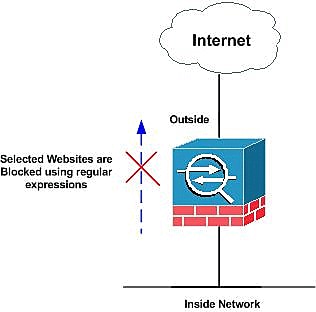
Configurations
This document uses these configurations:
ASA CLI Configuration
| ASA CLI Configuration |
|---|
ciscoasa#show running-config : Saved : ASA Version 7.2(2) ! hostname ciscoasa domain-name default.domain.invalid enable password 8Ry2YjIyt7RRXU24 encrypted names ! interface Ethernet0/0 nameif inside security-level 100 ip address 10.1.1.1 255.255.255.0 ! interface Ethernet0/1 nameif outside security-level 0 ip address 192.168.1.5 255.255.255.0 ! interface Ethernet0/2 nameif DMZ security-level 90 ip address 10.77.241.142 255.255.255.192 ! interface Ethernet0/3 shutdown no nameif no security-level no ip address ! interface Management0/0 shutdown no nameif no security-level no ip address ! passwd 2KFQnbNIdI.2KYOU encrypted regex urllist1 ".*\.([Ee][Xx][Ee]|[Cc][Oo][Mm]|[Bb][Aa][Tt]) HTTP/1.[01]" !--- Extensions such as .exe, .com, .bat to be captured and !--- provided the http version being used by web browser must be either 1.0 or 1.1 regex urllist2 ".*\.([Pp][Ii][Ff]|[Vv][Bb][Ss]|[Ww][Ss][Hh]) HTTP/1.[01]" !--- Extensions such as .pif, .vbs, .wsh to be captured !--- and provided the http version being used by web browser must be either !--- 1.0 or 1.1 regex urllist3 ".*\.([Dd][Oo][Cc]|[Xx][Ll][Ss]|[Pp][Pp][Tt]) HTTP/1.[01]" !--- Extensions such as .doc(word), .xls(ms-excel), .ppt to be captured and provided !--- the http version being used by web browser must be either 1.0 or 1.1 regex urllist4 ".*\.([Zz][Ii][Pp]|[Tt][Aa][Rr]|[Tt][Gg][Zz]) HTTP/1.[01]" !--- Extensions such as .zip, .tar, .tgz to be captured and provided !--- the http version being used by web browser must be either 1.0 or 1.1 regex domainlist1 "\.yahoo\.com" regex domainlist2 "\.myspace\.com" regex domainlist3 "\.youtube\.com" !--- Captures the URLs with domain name like yahoo.com, !--- youtube.com and myspace.com regex contenttype "Content-Type" regex applicationheader "application/.*" !--- Captures the application header and type of !--- content in order for analysis boot system disk0:/asa802-k8.bin ftp mode passive dns server-group DefaultDNS domain-name default.domain.invalid access-list inside_mpc extended permit tcp any any eq www access-list inside_mpc extended permit tcp any any eq 8080 !--- Filters the http and port 8080 !--- traffic in order to block the specific traffic with regular !--- expressions pager lines 24 mtu inside 1500 mtu outside 1500 mtu DMZ 1500 no failover icmp unreachable rate-limit 1 burst-size 1 asdm image disk0:/asdm-602.bin no asdm history enable arp timeout 14400 route DMZ 0.0.0.0 0.0.0.0 10.77.241.129 1 timeout xlate 3:00:00 timeout conn 1:00:00 half-closed 0:10:00 udp 0:02:00 icmp 0:00:02 timeout sunrpc 0:10:00 h323 0:05:00 h225 1:00:00 mgcp 0:05:00 mgcp-pat 0:05:00 timeout sip 0:30:00 sip_media 0:02:00 sip-invite 0:03:00 sip-disconnect 0:02:00 timeout uauth 0:05:00 absolute dynamic-access-policy-record DfltAccessPolicy http server enable http 0.0.0.0 0.0.0.0 DMZ no snmp-server location no snmp-server contact snmp-server enable traps snmp authentication linkup linkdown coldstart no crypto isakmp nat-traversal telnet timeout 5 ssh timeout 5 console timeout 0 threat-detection basic-threat threat-detection statistics access-list ! class-map type regex match-any DomainBlockList match regex domainlist1 match regex domainlist2 match regex domainlist3 !--- Class map created in order to match the domain names !--- to be blocked class-map type inspect http match-all BlockDomainsClass match request header host regex class DomainBlockList !--- Inspect the identified traffic by class !--- "DomainBlockList" class-map type regex match-any URLBlockList match regex urllist1 match regex urllist2 match regex urllist3 match regex urllist4 !--- Class map created in order to match the URLs !--- to be blocked class-map inspection_default match default-inspection-traffic class-map type inspect http match-all AppHeaderClass match response header regex contenttype regex applicationheader !--- Inspect the captured traffic by regular !--- expressions "content-type" and "applicationheader" class-map httptraffic match access-list inside_mpc !--- Class map created in order to match the !--- filtered traffic by ACL class-map type inspect http match-all BlockURLsClass match request uri regex class URLBlockList ! !--- Inspect the identified traffic by class !--- "URLBlockList" ! policy-map type inspect dns preset_dns_map parameters message-length maximum 512 policy-map type inspect http http_inspection_policy parameters protocol-violation action drop-connection class AppHeaderClass drop-connection log match request method connect drop-connection log class BlockDomainsClass reset log class BlockURLsClass reset log !--- Define the actions such as drop, reset or log !--- in the inspection policy map policy-map global_policy class inspection_default inspect dns preset_dns_map inspect ftp inspect h323 h225 inspect h323 ras inspect netbios inspect rsh inspect rtsp inspect skinny inspect esmtp inspect sqlnet inspect sunrpc inspect tftp inspect sip inspect xdmcp policy-map inside-policy class httptraffic inspect http http_inspection_policy !--- Map the inspection policy map to the class !--- "httptraffic" under the policy map created for the !--- inside network traffic ! service-policy global_policy global service-policy inside-policy interface inside !--- Apply the policy to the interface inside where the websites will be blocked prompt hostname context Cryptochecksum:e629251a7c37af205c289cf78629fc11 : end ciscoasa# |
ASA Configuration 7.2(x) with ASDM 5.2
Complete these steps in order to configure the regular expressions and apply them to MPF to block the specific websites:
-
Create Regular Expressions
Choose Configuration > Global Objects > Regular Expressions and click Add under the Regular Expression tab in order to create regular expressions.
-
Create a regular expression domainlist1 in order to capture the domain name yahoo.com. Click OK.
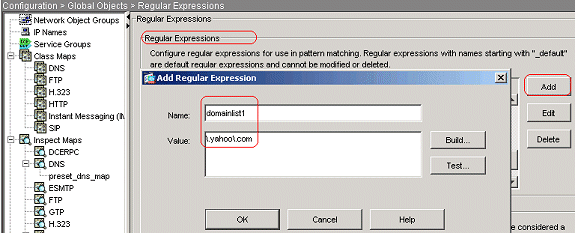
-
Create a regular expression domainlist2 in order to capture the domain name myspace.com. Click OK.
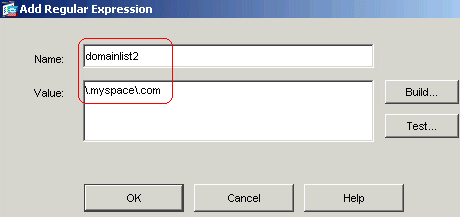
-
Create a regular expression domainlist3 in order to capture the domain name youtube.com. Click OK.
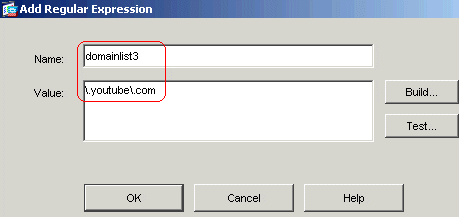
-
Create a regular expression urllist1 in order to capture the file extensions such as exe, com, and bat provided that the http version used by the web browser must be either 1.0 or 1.1. Click OK.
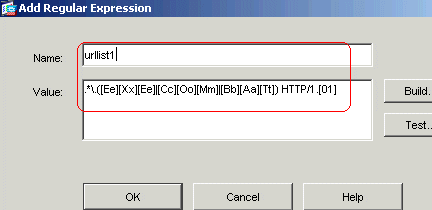
-
Create a regular expression urllist2 in order to capture the file extensions, such as pif, vbs, and wsh provided that the HTTP version that is used by the web browser is either 1.0 or 1.1. Click OK.
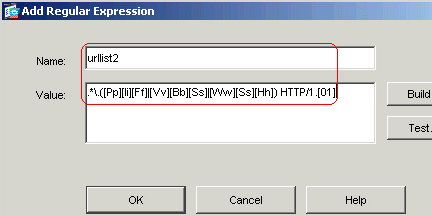
-
Create a regular expression urllist3 in order to capture the file extensions, such as doc, xls, and ppt provided that the HTTP version that is used by the web browser is either 1.0 or 1.1. Click OK.
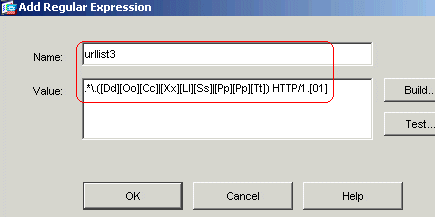
-
Create a regular expression urllist4 in order to capture the file extensions, such as zip, tar, and tgz provided that the HTTP version that is used by the web browser is either 1.0 or 1.1. Click OK.
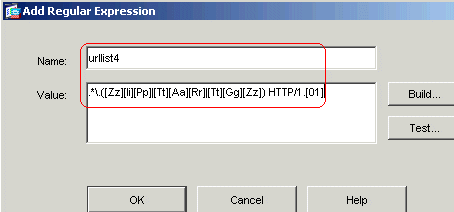
-
Create a regular expression contenttype in order to capture the content type. Click OK.
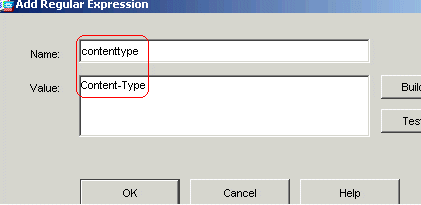
-
Create a regular expression applicationheader in order to capture the various application header. Click OK.
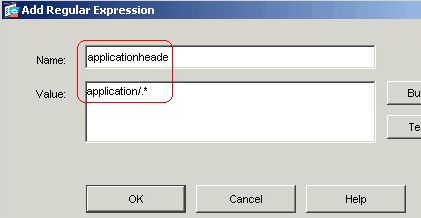
Equivalent CLI Configuration
ASA CLI Configuration ciscoasa#configure terminal ciscoasa(config)#regex urllist1 ".*\.([Ee][Xx][Ee]|[Cc][Oo][Mm]|[Bb][Aa][Tt])$ ciscoasa(config)#regex urllist2 ".*\.([Pp][Ii][Ff]|[Vv][Bb][Ss]|[Ww][Ss][Hh])$ ciscoasa(config)#regex urllist3 ".*\.([Dd][Oo][Cc]|[Xx][Ll][Ss]|[Pp][Pp][Tt])$ ciscoasa(config)#regex urllist4 ".*\.([Zz][Ii][Pp]|[Tt][Aa][Rr]|[Tt][Gg][Zz])$ ciscoasa(config)#regex domainlist1 "\.yahoo\.com" ciscoasa(config)#regex domainlist2 "\.myspace\.com" ciscoasa(config)#regex domainlist3 "\.youtube\.com" ciscoasa(config)#regex contenttype "Content-Type" ciscoasa(config)#regex applicationheader "application/.*"
-
-
Create Regular Expression Classes
Choose Configuration > Global Objects > Regular Expressions, and click Add under the Regular Expression Classes tab in order to create the various classes.
-
Create a regular expression class DomainBlockList in order to match any of the regular expressions: domainlist1, domainlist2, and domainlist3. Click OK.
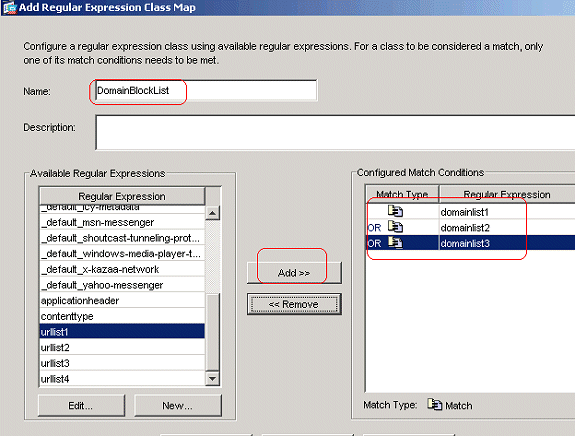
-
Create a regular expression class URLBlockList in order to match any of the regular expressions: urllist1, urllist2, urllist3, and urllist4. Click OK.
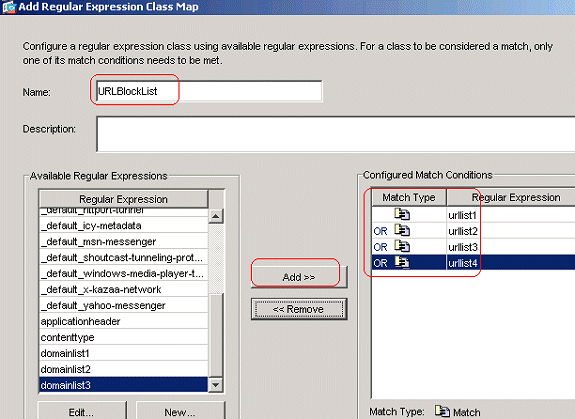
Equivalent CLI Configuration
ASA CLI Configuration ciscoasa#configure terminal ciscoasa(config)#class-map type inspect http match-all BlockDomainsClass ciscoasa(config-cmap)#match request header host regex class DomainBlockList ciscoasa(config-cmap)#exit ciscoasa(config)#class-map type regex match-any URLBlockList ciscoasa(config-cmap)#match regex urllist1 ciscoasa(config-cmap)#match regex urllist2 ciscoasa(config-cmap)#match regex urllist3 ciscoasa(config-cmap)#match regex urllist4 ciscoasa(config-cmap)#exit
-
-
Inspect the identified traffic with Class maps
Choose Configuration > Global Objects > Class Maps > HTTP > Add in order to create a class map to inspect the HTTP traffic identified by various regular expressions.
-
Create a class map AppHeaderClass in order to match the response header with regular expression captures.
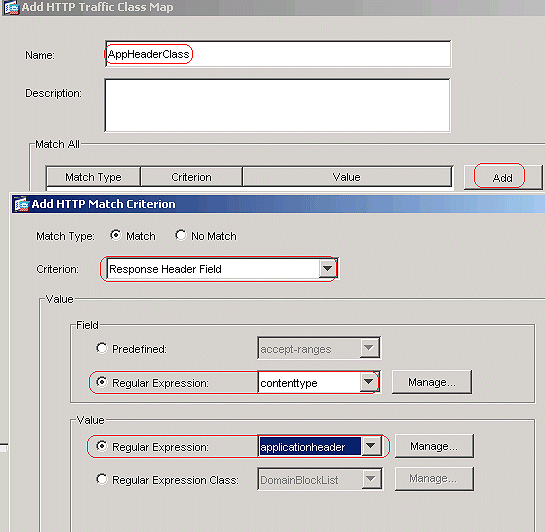
Click OK.
-
Create a class map BlockDomainsClass in order to match the request header with regular expression captures.
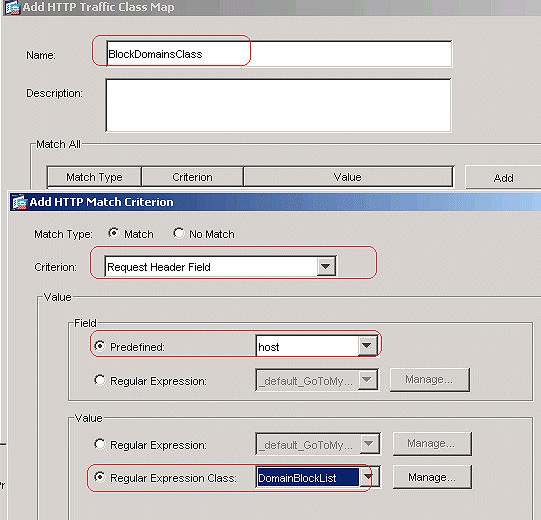
Click OK.
-
Create a class map BlockURLsClass in order to match the request URI with regular expression captures.
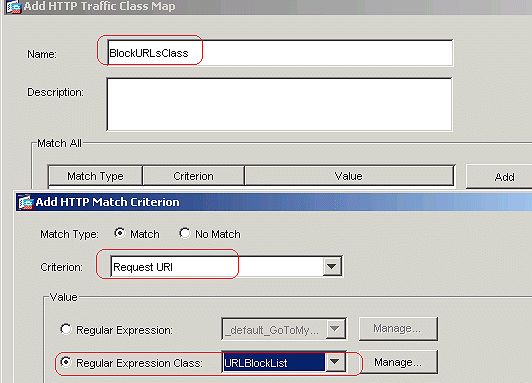
Click OK.
Equivalent CLI Configuration
ASA CLI Configuration ciscoasa#configure terminal ciscoasa(config)#class-map type inspect http match-all AppHeaderClass ciscoasa(config-cmap)#match response header regex contenttype regex applicationheader ciscoasa(config-cmap)#exit ciscoasa(config)#class-map type inspect http match-all BlockDomainsClass ciscoasa(config-cmap)#match request header host regex class DomainBlockList ciscoasa(config-cmap)#exit ciscoasa(config)#class-map type inspect http match-all BlockURLsClass ciscoasa(config-cmap)#match request uri regex class URLBlockList ciscoasa(config-cmap)#exit
-
-
Set the actions for the matched traffic in the inspection policy
Choose Configuration > Global Objects > Inspect Maps > HTTP in order to create a http_inspection_policy to set the action for the matched traffic. Click Add and Apply.
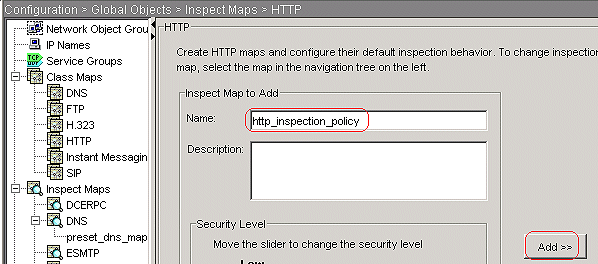
-
Choose Configuration > Global Objects > Inspect Maps > HTTP > http_inspection_policy and click Advanced View > Inspections > Add in order to set the actions for the various Classes created so far.
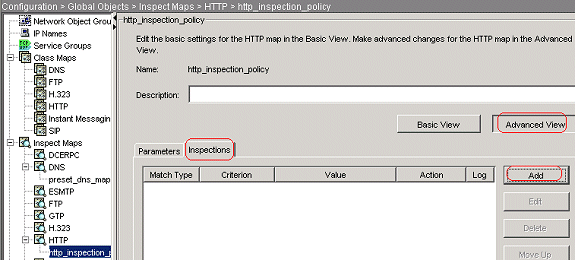
Click OK.
-
Set the action as Drop Connection; Enable the logging for the Criterion as Request Method and Value as connect.
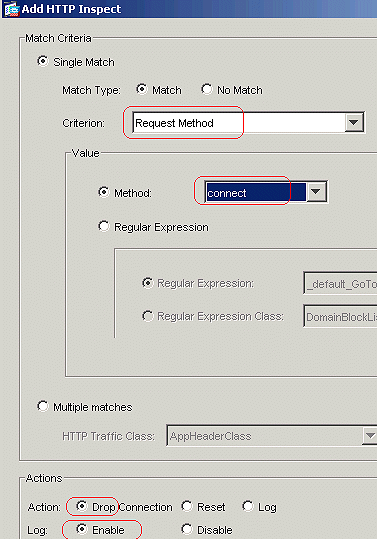
Click OK.
-
Set the action as Drop Connection, and Enable the logging for the class AppHeaderClass.
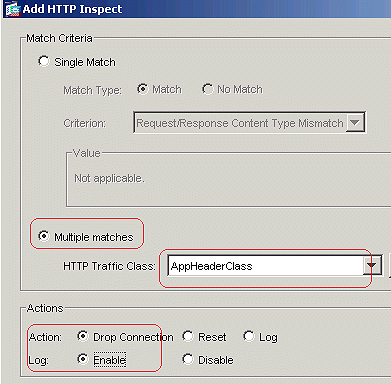
Click OK.
-
Set the action as Reset, and Enable the logging for the class BlockDomainsClass.
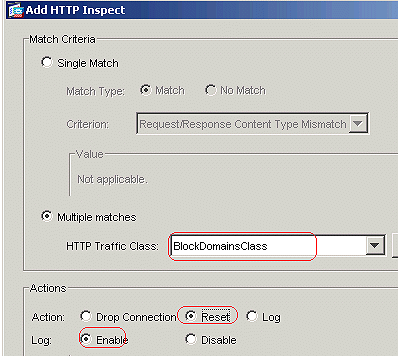
Click OK.
-
Set the action as Reset, and Enable the logging for the class BlockURLsClass.
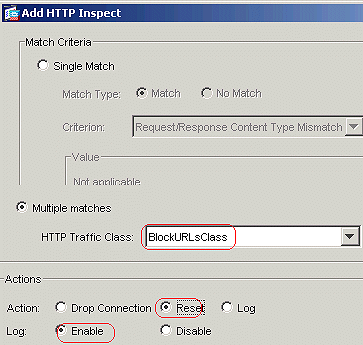
Click OK.
Click Apply.
Equivalent CLI Configuration
ASA CLI Configuration ciscoasa#configure terminal ciscoasa(config)#policy-map type inspect http http_inspection_policy ciscoasa(config-pmap)#parameters ciscoasa(config-pmap-p)#match request method connect ciscoasa(config-pmap-c)#drop-connection log ciscoasa(config-pmap-c)#class AppHeaderClass ciscoasa(config-pmap-c)#drop-connection log ciscoasa(config-pmap-c)#class BlockDomainsClass ciscoasa(config-pmap-c)#reset log ciscoasa(config-pmap-c)#class BlockURLsClass ciscoasa(config-pmap-c)#reset log ciscoasa(config-pmap-c)#exit ciscoasa(config-pmap)#exit
-
-
Apply the inspection http policy to the interface
Choose Configuration > Security Policy > Service Policy Rules > Add > Add Service Policy Rule under the Service Policy Rules tab.
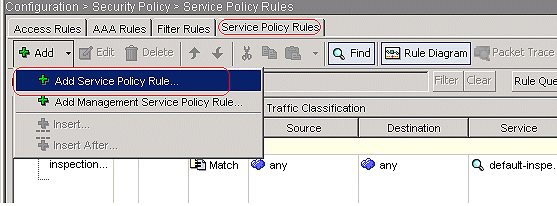
-
HTTP Traffic
-
Choose the Interface radio button with the inside interface from the drop-down menu and the Policy Name as inside-policy. Click Next.
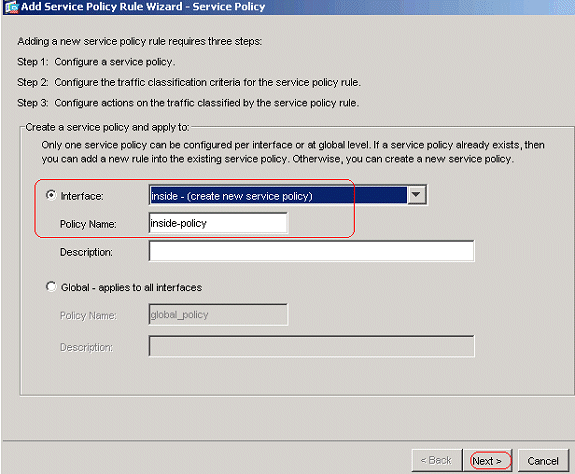
-
Create a class map httptraffic, and check the Source and Destination IP Address (uses ACL). Click Next.
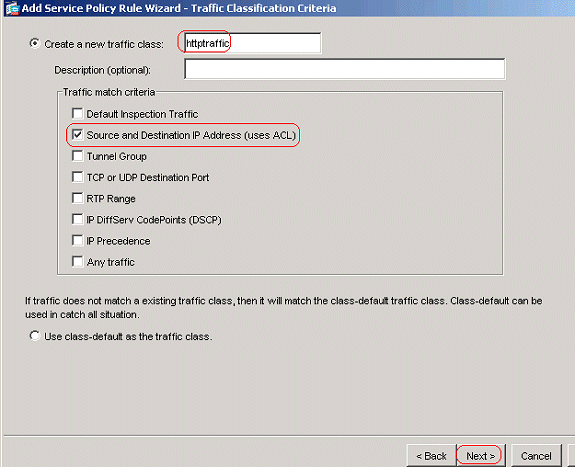
-
Choose the Source and Destination as any with the TCP port as HTTP. Click Next.
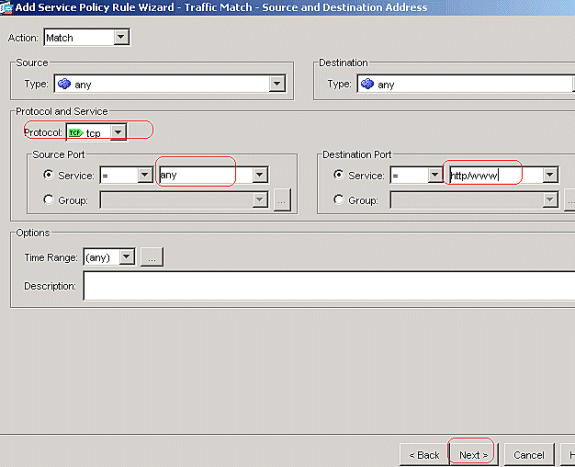
-
Check the HTTP radio button, and click Configure.
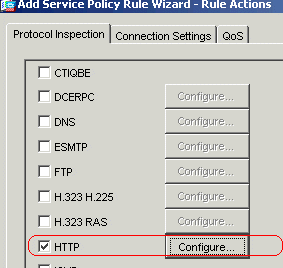
-
Check the radio button Select a HTTP inspect map for the control over inspection. Click OK.
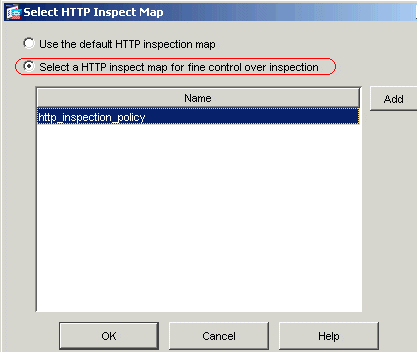
-
Click Finish.
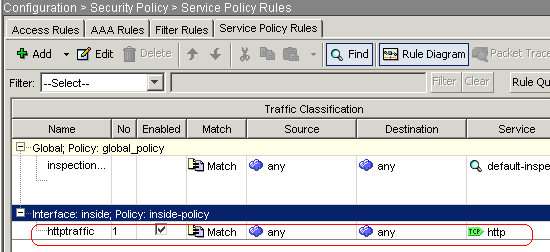
-
-
Port 8080 Traffic
-
Again, click Add > Add Service Policy Rule.
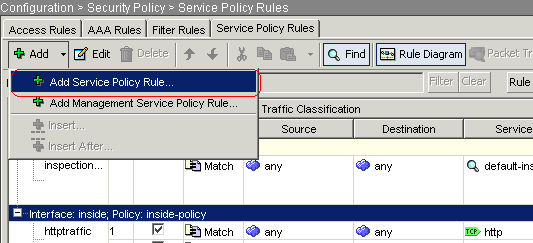
-
Click Next.
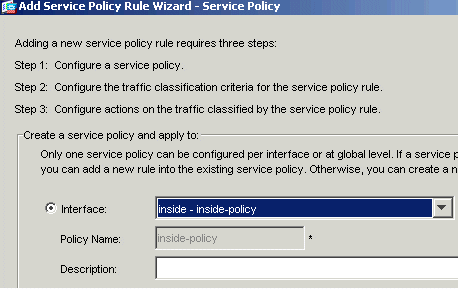
-
Choose the Add rule to existing traffic class radio button, and choose httptraffic from the drop-down menu. Click Next.
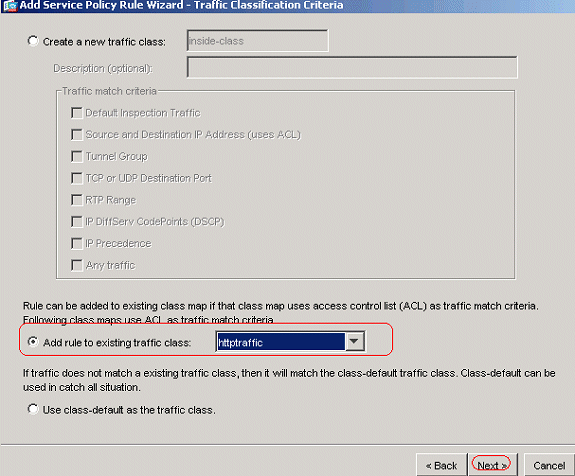
-
Choose the Source and Destination as any with the TCP port as 8080. Click Next.
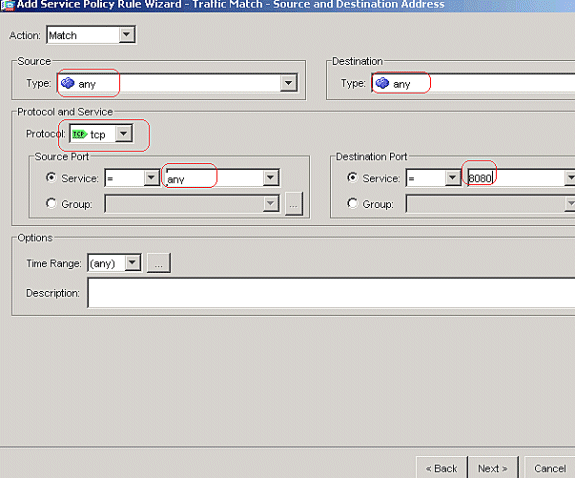
-
Click Finish.
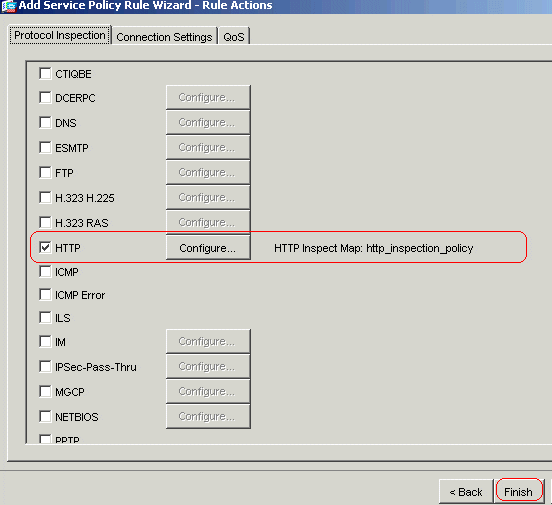
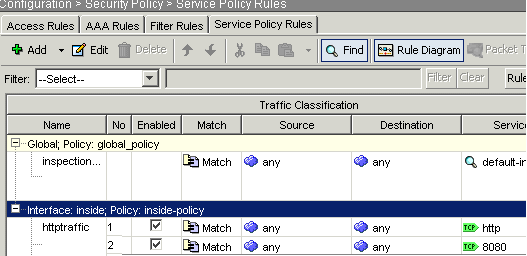
Click Apply.
Equivalent CLI Configuration
ASA CLI Configuration ciscoasa#configure terminal ciscoasa(config)#access-list inside_mpc extended permit tcp any any eq www ciscoasa(config)#access-list inside_mpc extended permit tcp any any eq 8080 ciscoasa(config)#class-map httptraffic ciscoasa(config-cmap)#match access-list inside_mpc ciscoasa(config-cmap)#exit ciscoasa(config)#policy-map inside-policy ciscoasa(config-pmap)#class httptraffic ciscoasa(config-pmap-c)#inspect http http_inspection_policy ciscoasa(config-pmap-c)#exit ciscoasa(config-pmap)#exit ciscoasa(config)#service-policy inside-policy interface inside
-
-
Verify
Use this section to confirm that your configuration works properly.
The Output Interpreter Tool (registered customers only) (OIT) supports certain show commands. Use the OIT to view an analysis of show command output.
-
show running-config regex—Shows the regular expressions that have been configured
ciscoasa#show running-config regex regex urllist1 ".*\.([Ee][Xx][Ee]|[Cc][Oo][Mm]|[Bb][Aa][Tt]) HTTP/1.[01]" regex urllist2 ".*\.([Pp][Ii][Ff]|[Vv][Bb][Ss]|[Ww][Ss][Hh]) HTTP/1.[01]" regex urllist3 ".*\.([Dd][Oo][Cc]|[Xx][Ll][Ss]|[Pp][Pp][Tt]) HTTP/1.[01]" regex urllist4 ".*\.([Zz][Ii][Pp]|[Tt][Aa][Rr]|[Tt][Gg][Zz]) HTTP/1.[01]" regex domainlist1 "\.yahoo\.com" regex domainlist2 "\.myspace\.com" regex domainlist3 "\.youtube\.com" regex contenttype "Content-Type" regex applicationheader "application/.*" ciscoasa#
-
show running-config class-map—Shows the class maps that have been configured
ciscoasa#show running-config class-map ! class-map type regex match-any DomainBlockList match regex domainlist1 match regex domainlist2 match regex domainlist3 class-map type inspect http match-all BlockDomainsClass match request header host regex class DomainBlockList class-map type regex match-any URLBlockList match regex urllist1 match regex urllist2 match regex urllist3 match regex urllist4 class-map inspection_default match default-inspection-traffic class-map type inspect http match-all AppHeaderClass match response header regex contenttype regex applicationheader class-map httptraffic match access-list inside_mpc class-map type inspect http match-all BlockURLsClass match request uri regex class URLBlockList ! ciscoasa#
-
show running-config policy-map type inspect http—Shows the policy maps that inspects the http traffic that have been configured
ciscoasa#show running-config policy-map type inspect http ! policy-map type inspect http http_inspection_policy parameters protocol-violation action drop-connection class AppHeaderClass drop-connection log match request method connect drop-connection log class BlockDomainsClass reset log class BlockURLsClass reset log ! ciscoasa#
-
show running-config policy-map—Displays all the policy-map configurations as well as the default policy-map configuration
ciscoasa#show running-config policy-map ! policy-map type inspect dns preset_dns_map parameters message-length maximum 512 policy-map type inspect http http_inspection_policy parameters protocol-violation action drop-connection class AppHeaderClass drop-connection log match request method connect drop-connection log class BlockDomainsClass reset log class BlockURLsClass reset log policy-map global_policy class inspection_default inspect dns preset_dns_map inspect ftp inspect h323 h225 inspect h323 ras inspect netbios inspect rsh inspect rtsp inspect skinny inspect esmtp inspect sqlnet inspect sunrpc inspect tftp inspect sip inspect xdmcp policy-map inside-policy class httptraffic inspect http http_inspection_policy ! ciscoasa#
-
show running-config service-policy—Displays all currently running service policy configurations
ciscoasa#show running-config service-policy service-policy global_policy global service-policy inside-policy interface inside
-
show running-config access-list—Displays the access-list configuration that runs on the security appliance
ciscoasa#show running-config access-list access-list inside_mpc extended permit tcp any any eq www access-list inside_mpc extended permit tcp any any eq 8080 ciscoasa#
Troubleshoot
This section provides information you can use to troubleshoot your configuration.
Note: Refer to Important Information on Debug Commands before you use debug commands.
-
debug http—Shows the debug messages for HTTP traffic.
Related Information
Revision History
| Revision | Publish Date | Comments |
|---|---|---|
1.0 |
10-Jan-2008 |
Initial Release |
Contact Cisco
- Open a Support Case

- (Requires a Cisco Service Contract)

































 Feedback
Feedback